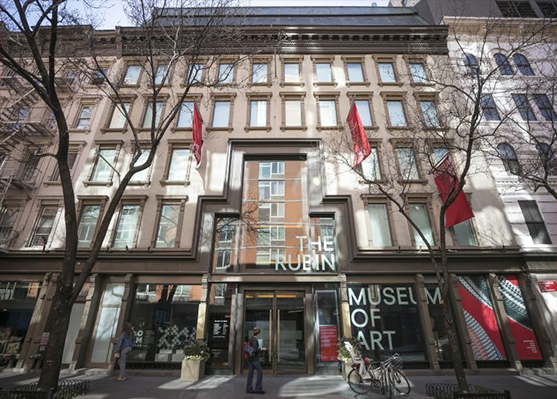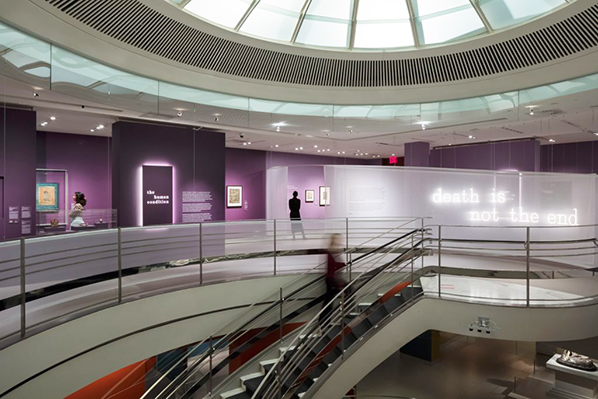뉴욕 히말라야 미술관 루빈뮤지엄(Rubin Museum of Art) 10/6 폐관
뉴욕 유일 불교미술관 루빈 뮤지엄 폐관한다
네팔, 티벳 미술 홍보...재정난으로 부동산 매각

Photo: Rubin Museum of Art
맨해튼의 히말라야 미술 전문관 루빈뮤지엄(Rubin Museum of Art, 150 West 17th St.)이 올 10월 6일 문을 닫는다.
뉴욕타임스에 따르면, 루빈뮤지엄은 재정난을 겪어왔으며 약탈된 유물을 전시했다는 비판에 직면해왔다. 조릿 브리츠기(Jorrit Britschgi) 루빈뮤지엄 관장은 자금난으로 2019년 24명의 직원을 해고했다. 이번 폐관 결정으로 직원의 40%가 실직할 것으로 예상된다.
뉴욕시 미술관/박물관들은 코로나19 팬데믹으로 방문객이 감소하면서 심각한 현금 부족에 직면해 직원 해고와 티켓가 인상으로 지탱해왔다. 그러나, 루빈뮤지엄은 아예 부동산까지 매각하게되는 극단적인 조치를 취해 충격을 주고 있다.
루빈뮤지엄은 지난해 12월 16세기경 바이라바(Bhairava)신의 탈 등 3점을 네팔 정부에 반환했다. 이 송환은 2022년 9월 소셜미디어와 언론을 통해 1990년대 네팔의 돌라카에서 도난당한 물품으로 폭로되었기 때문이다.

Photo: Rubin Museum of Art
브리츠기 관장은 뮤지엄 건물을 매각해 루빈의 유지 기금에 예치될 것이라고 밝혔다. 루빈뮤지엄은 공간을 잃어버리지만, 히말라야 미술을 홍보하기 위해 대여 등 업무는 지속할 예정이다. 그러나, 존제이칼리지의 미술범죄학 교수 에린 톰슨은 대중이 미술 컬렉션에 정기적으로 접근할 수 없다면, 미술관이 자선단체로서 세금 공제 혜택에 불리할 것이라고 지적했다.
2004년 도널드 루빈(Donald Rubin)과 셸리 루빈(Shelley Rubin)이 아트 컬렉션을 홍보하기 위해 설립한 루빈뮤지엄은 7만평방 피트 규모에 1,500년 역사에 걸쳐 약 4천여점의 티벳, 네팔 등 히말라야 미술품을 소장하고 있다. 루빈 가문은 1998년 맨해튼 첼시 17스트릿 건물을 2천2백만 달러에 구입했고, 1층엔 바니즈 뉴욕 백화점이 파산신청한 2020년까지 대여했었다. 미술관은 Beyer Blinder Belle와 Atelier Imrey Culbert가 설계했으며, 로고는 I Love NY의 그래픽 디자이너 밀턴 글레이저(Milton Glaser)가 디자인했다.
한인 사진작가 김아타(Atta Kim)씨가 2010년 11월 5인전 'Grain of Emptiness'에 참가했으며, 2011년 3월 얼음 부처 퍼포먼스 'Monologue of Ice'를 했다. 또한, 로버트 마우리의 한국미술 강연, 그레이스 켈리(정혜영) 재즈 콘서트, 모모푸쿠 데이빗 장과 르 버나단 에릭 리퍼트의 대화 등이 열렸다. 루빈뮤지엄의 마지막 전시는 개관 20주년을 기념하는 30인전 'Reimagine: Himalayan Art Now'(3/15-10/6, 2024)다.
A LETTER TO OUR MEMBERS AND COMMUNITY FROM EXECUTIVE DIRECTOR JORRIT BRITSCHGI
Dear Rubin Community,
As we embark on our 20th anniversary year, I’m writing to share important news about the next phase in the Rubin’s history.
Over the last several years, we have been piloting new ways of reaching people, pursuing projects from Bilbao to Boston, from Kathmandu to London, from New York to Venice. In the digital space, we’ve launched major resources to learn about Himalayan art, and shifted some of our programs to become podcasts, reaching people in over 150 countries. We’ve been encouraged by the people we’ve reached through these endeavors and the support from the individuals and institutions who share our vision to bring Himalayan art to people wherever they are.
During this phase of experimentation and reinvention, we examined how to most effectively use our collection, knowledge, creativity, networks, and financial resources in order to best serve you, the public, for the long-term and with the greatest impact. After an in-depth analysis of the cultural sector and our important place in it, we have decided to fully embrace and pursue the model of being a global museum, serving the public locally, nationally and internationally.
In light of this new direction, we will close our New York City building this fall, and become a museum without walls. This has been a difficult decision, especially given the departure of some of the staff that have made this place so exceptional. Ultimately, this decision will allow us to serve more people, digitally and in person.
We are proud of the groundbreaking exhibitions, programs, and gatherings we have held on 17th Street. Many of you have shared with us how our unique building has been a place for nourishing the mind and the heart, and even for experiences that changed your lives. Thank you for the trust you have placed in us.
The art in our galleries teaches us that change is constant and inevitable. We take inspiration from this, as we boldly let go of an old model and redefine what it means to be a museum in the 21st century. We will build on partnerships and collaborations with people from the Himalayan region, diaspora, and beyond, and make our offerings available globally, supporting research, artistic expression and creativity. Existing Rubin programs such as the pioneering Project Himalayan Art, which provides physical and digital scholarly resources for the study of Himalayan art with an exhibition traveling nationally, and our interactive Mandala Lab, soon opening in Milan, are only the beginning. While we’re becoming a global museum, we remain rooted in New York City. The Rubin’s Social, Emotional, and Ethical Learning® curriculum, incorporated in partnership with Emory University, will serve schools and teachers in New York City and beyond through digital and in-person traveling Mandala Lab experiences, and will be expanded in the coming years.
What will NOT change is our mission: to broadly share Himalayan art, its cultural context, and the insights it provides for humanity. We will continue to care for, study, and share our collection as the foundation of our organization, through an expansive loan program, and we will keep on curating, creating, and traveling Rubin projects. We also hope to find a new permanent home for our Tibetan Buddhist Shrine Room in New York City in the coming months.
We are deeply grateful to everyone who has walked through our doors since 2004 and helped the Rubin transform from a private collection into a singular public institution.
While this change means letting go of our physical space in pursuit of a new model, our mission to advance the appreciation and understanding of Himalayan art globally remains as strong as ever. Please come and visit the upcoming Reimagine: Himalayan Art Now exhibition before October 6 and we invite you to continue to be a part of our journey in the decades to come.
Sincerely,
Jorrit Britschgi
Executive Director
https://rubinmuseum.org
*ICP 첫 한인작가 개인전 김아타(Atta Kim) 인터뷰, 2006
https://www.nyculturebeat.com/index.php?mid=Art2&document_srl=4042344




 조안 스나이더(Joan Snyder) 'Come Close' @캐나다 뉴욕 갤러리(2...
조안 스나이더(Joan Snyder) 'Come Close' @캐나다 뉴욕 갤러리(2...
 국제사진센터 개관 50주년 특별전(ICP at 50: From the Collectio...
국제사진센터 개관 50주년 특별전(ICP at 50: From the Collectio...

